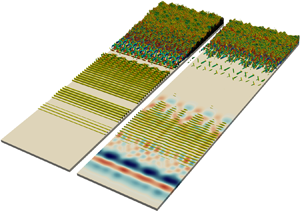Crossref Citations
This article has been cited by the following publications. This list is generated based on data provided by
Crossref.
Mons, Vincent
Du, Yifan
and
Zaki, Tamer A.
2021.
Ensemble-variational assimilation of statistical data in large-eddy simulation.
Physical Review Fluids,
Vol. 6,
Issue. 10,
Paquin, Laura A.
Skinner, Shaun
and
Laurence, Stuart J.
2022.
Boundary-Layer Disturbances and Surface Heat-Flux Profiles on a Cooled Slender Cone.
Zhou, Teng
Liu, Zaijie
Lu, Yuhan
Kang, Dake
and
Yan, Chao
2022.
Control of oblique breakdown in a supersonic boundary layer employing a local cooling strip.
Journal of Fluid Mechanics,
Vol. 949,
Issue. ,
Paquin, Laura A.
Skinner, Shaun N.
and
Laurence, Stuart J.
2023.
Hypersonic Boundary-Layer Disturbances on a Cooled, Slender Cone at Mach 6.
Journal of Spacecraft and Rockets,
Vol. 60,
Issue. 2,
p.
533.
Jahanbakhshi, Reza
and
Zaki, Tamer A.
2023.
Optimal two-dimensional roughness for transition delay in high-speed boundary layer.
Journal of Fluid Mechanics,
Vol. 968,
Issue. ,
Unnikrishnan, S.
2023.
Recent advances in feature extraction techniques for high-speed flowfields.
Progress in Aerospace Sciences,
Vol. 140,
Issue. ,
p.
100918.
Clark Di Leoni, Patricio
Lu, Lu
Meneveau, Charles
Karniadakis, George Em
and
Zaki, Tamer A.
2023.
Neural operator prediction of linear instability waves in high-speed boundary layers.
Journal of Computational Physics,
Vol. 474,
Issue. ,
p.
111793.
Nibourel, Pierre
Leclercq, Colin
Demourant, Fabrice
Garnier, Eric
and
Sipp, Denis
2023.
Reactive control of second Mack mode in a supersonic boundary layer with free-stream velocity/density variations.
Journal of Fluid Mechanics,
Vol. 954,
Issue. ,
Rezaee, Danial
2024.
On the use of time-dependent fluids for delaying onset of transition to turbulence in the flat plate boundary-layer flow: A passive control of flow.
Journal of Non-Newtonian Fluid Mechanics,
Vol. 324,
Issue. ,
p.
105184.
Morra, Pierluigi
Meneveau, Charles
and
Zaki, Tamer A.
2024.
ML for fast assimilation of wall-pressure measurements from hypersonic flow over a cone.
Scientific Reports,
Vol. 14,
Issue. 1,
Poulain, Arthur
Content, Cédric
Schioppa, Aldo
Nibourel, Pierre
Rigas, Georgios
and
Sipp, Denis
2024.
Adjoint-based optimisation of time- and span-periodic flow fields with Space–Time Spectral Method: Application to non-linear instabilities in compressible boundary layer flows.
Computers & Fluids,
Vol. 282,
Issue. ,
p.
106386.
Zhuang, Guo-Hui
Wan, Zhen-Hua
Liu, Nan-Sheng
Sun, De-Jun
and
Lu, Xi-Yun
2024.
Instability and transition control by steady local blowing/suction in a hypersonic boundary layer.
Journal of Fluid Mechanics,
Vol. 990,
Issue. ,
Hammachi, Riwan
Piot, Estelle
Deniau, Hugues
Brazier, Jean-Philippe
Daviller, Guillaume
and
Cardesa, José I.
2024.
Coherent structure tracking of the second Mack mode in transitional hypersonic boundary layers.
Journal of Physics: Conference Series,
Vol. 2753,
Issue. 1,
p.
012012.
Luo, Qingyong
Zhang, Xin-Lei
and
He, Guowei
2024.
Ensemble variational method with adaptive covariance inflation for learning neural network-based turbulence models.
Physics of Fluids,
Vol. 36,
Issue. 3,
Zaki, Tamer A.
and
Wang, Mengze
2025.
Data Driven Analysis and Modeling of Turbulent Flows.
p.
129.
Zhuang, Guo-Hui
Wan, Zhen-Hua
Zhang, Peng-Jun-Yi
Sun, De-Jun
Lu, Xi-Yun
and
Chang, Meng-Qi
2025.
Bayesian-Optimization-Based Delay Control of Hypersonic Boundary-Layer Transition.
AIAA Journal,
p.
1.
Tuna, Burak A.
Wu, Huixuan
Torok, Jackson
Tao, Xingtian
and
Zheng, Zhongquan
2025.
A topology-based method for assessing the complexity and unpredictability of unsteady flows.
Physics of Fluids,
Vol. 37,
Issue. 9,



